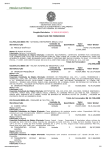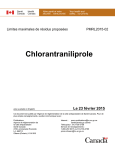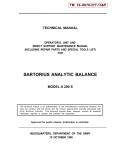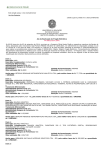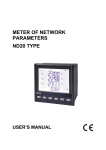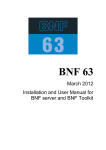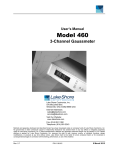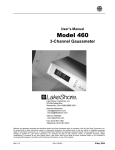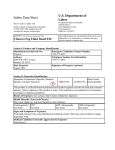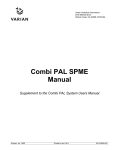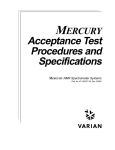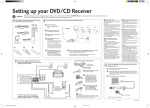Download Preview Labtrix start teaching method
Transcript
Dr Charlotte Wiles FLOW CHEMISTRY TEACHING METHOD 1 Personal Copy: This document may not, be distributed or resold by the recipient and may not be reproduced in a modified form. Dr Charlotte Wiles Table of Contents Chapter 1: Safe Working in a Laboratory 1. Safe Working in a Laboratory 3 4 1.1 Pre-laboratory Preparation 4 1.2 Personal Protective Equipment 4 1.3 General Safety Instructions 4 ® 1.4 Labtrix Start Safety Instructions 5 1.5 Risk Assessment 5 Chapter 2: Micro Reaction Technology 2. Introduction to Micro Reaction Technology 6 7 2.1 What is a Micro Reactor? 7 2.2 Advantages of Micro Reactors 7 2.3 How are Reactions Performed? 7 2.4 Aim of the Experiments 8 2.5 References 8 Chapter 3: Labtrix® Start, Micro Reaction Screening Apparatus 9 ® 3. General Labtrix Start Information 10 3.1 Micro Reactors 10 3.2 Reactor Holder and Peripherals 11 3.3 Liquid Handling 13 3.4 Thermal Control 14 3.5 Background Information 14 3.5.1 Reagent Preparation: How to make a Volumetric Stock Solution 14 3.5.2 Loading the Solution into a Gas-tight Syringe 15 3.5.3 Calculation of Reaction Time 15 3.5.4 Qualitative Analysis of Flow Reactions 16 3.5.5 Quantitative Analysis of Flow Reactions 16 3.5.6 Determination of Product Purity 17 Chapter 4: Experimental Section 18 Method 1: Synthesis of 3-Phenyl-5-(trifluoromethyl)-4,5-dihydro-1H-pyrazol-5-ol 19 Method 2: Synthesis of (E)-Ethyl 2-cyano-3-(3,5-dimethoxyphenyl)acrylate 25 Method 3: Synthesis of (3aR,7aS)-5-Methyl-3a,4,7,7a-tetrahydroisobenzofuran-1,3-dione 31 Method 4: Synthesis of Coumarins under Continuous Flow 37 Method 5: Synthesis of 1-Phenylpropan-1-ol via a Continuous Flow Grignard Reaction 44 APPENDIX I: Labtrix® Start Spare Parts/Part Number List 51 APPENDIX II: Material Compatibilities 52 APPENDIX III: Model Answers 53 2 Personal Copy: This document may not, be distributed or resold by the recipient and may not be reproduced in a modified form. Dr Charlotte Wiles CHAPTER 4: EXPERIMENTAL SECTION 3 Personal Copy: This document may not, be distributed or resold by the recipient and may not be reproduced in a modified form. Dr Charlotte Wiles Method 1. Synthesis of 3-Phenyl-5-(trifluoromethyl)-4,5-dihydro-1H-pyrazol-5-ol Introduction: The aim of the experiment is to optimise the reaction time and temperature to maximise the proportion of 3phenyl-5-(trifluoromethyl)-4,5-dihydro-1H-pyrazol-5-ol, prior to synthesising ~ 100 mg of material for analysis by NMR spectroscopy. Depending on equipment availability, reaction success will be determined using Gas-Chromatography (GCFID) analysis or Thin Layer Chromatography (TLC). 1. Risk Assessment Students are reminded that they have a legal responsibility to take all necessary precautions to ensure the safety of themselves and others in the Laboratory during the course of this experiment. The substances especially harmful to health for this experiment are; 1. 4,4,4-Trifluoro-1-phenyl-1,3-butanedione: Harmful by inhalation, in contact with skin and eyes. 2. Hydrazine monohydrate: Flammable. May cause cancer. Toxic by inhalation, in contact with skin and if swallowed. May cause sensitization by skin contact. Very toxic to aquatic organisms, may cause long-term adverse effects in the aquatic environment (Exposure limits; STEL = 0.1 ppm). 3. Phenyl-5-(trifluoromethyl)-4,5-dihydro-1H-pyrazol-5-ol: Harmful by inhalation and in contact with skin. 4. Ethanol: Highly flammable liquid and vapour. Harmful by inhalation and ingestion. Delayed effects may include depression of the central nervous system, narcosis and damage to the heart (Exposure limits; TWA = 1000 ppm). 5. Acetone: Highly flammable liquid. Harmful by inhalation, ingestion and contact with skin and eyes (Exposure limits; TWA = 500 ppm). 6. Ethyl acetate: Highly flammable. Harmful by inhalation; may cause drowsiness (Exposure limits; PEL 400 ppm). 7. Hexane: Highly flammable. May cause impaired fertility. Irritating to the eyes, skin and central nervous system. Please refer to the material safety data sheet for each component to ensure the most up to date safety information is known and adhere to the following precautions; Gloves, safety glasses and a laboratory coat must be worn throughout the practical session The micro reaction equipment must be set-up within a fume cupboard and used with the sash closed The preparation of stock solutions must be conducted within a fume cupboard Good laboratory practise should be employed throughout the practical session All waste generated from this reaction must be placed in an appropriate labelled waste container 4 Personal Copy: This document may not, be distributed or resold by the recipient and may not be reproduced in a modified form. Dr Charlotte Wiles 2. Reagents and Solvents Name 4,4,4-Trifluoro-1-phenyl-1,3-butanedione Hydrazine monohydrate Purity Molecular Weight Density (%) (g mol-1) (g ml-1) 99 216.16 N/A +98 50.06 1.027 Ethanol Laboratory reagent grade 46.06 0.780 Acetone Laboratory reagent grade 58.08 0.790 Ethyl acetate Laboratory reagent grade 88.10 0.897 Hexane Laboratory reagent grade 86.18 0.655 99.9 N/A N/A Deuterated dimethyl sulfoxide 3. Analysis Conditions Depending on equipment availability, the micro reactions will be quantified using GC-FID or qualified using TLC under the conditions outlined below. 3.1 GC-FID Methodology Using a gas chromatography (GC-FID) operated under the conditions outlined in Chapter 3, Section 1.5.5, the following retention times are obtained for the solvents, reagents and reaction product; Name Retention Time (min) 4,4,4-Trifluoro-1-phenyl-1,3-butanedione 2.82 Ethanol 1.42 3-Phenyl-5-(trifluoromethyl)-4,5-dihydro-1H-pyrazol-5-ol 3.52 Upon analysis of the samples generated, calculate the percentage conversion of 4,4,4-trifluoro-1-phenyl-1,3-butandione to 3-phenyl-5-(trifluoromethyl)-4,5-dihydro-1H-pyrazol-5-ol using peak area. 3.2 TLC Analysis Thin layer chromatography is carried out using Kieselgel 60, HF254 alumina backed TLC plates, with 80:20 hexane:ethyl acetate used as eluent. Visualisation is achieved using fluorescence on exposure to short wave ultra violet light ( 254 nm). The solvent front is marked with a pencil and the Rf values for the starting material and product. The effect of flow reaction conditions can be assessed qualitatively based on the appearance of the product and consumption of the starting material. 5 Personal Copy: This document may not, be distributed or resold by the recipient and may not be reproduced in a modified form. Dr Charlotte Wiles 4. Experimental Conditions 4.1 Stock Solutions Using the following weights and volumes, prepare the stock solutions volumetrically; see introductory information for details of how to do this-if unsure consult a demonstrator. Stock No. Solution Quantity Volumetric Flask Concentration (ml) (M) 1 4,4,4-Trifluoro-1-phenyl-1,3-butanedione 1.08 g 5.00 1.00 2 Hydrazine monohydrate 0.27 ml 5.00 1.10 4.2 Micro Reactor Set-up The reactions will be performed using reactor type 3223 (Volume = 10 µl) and the reagents will be introduced into the reactor using the following inlets; Before starting the reaction; a. Check that the reactor holder contains reactor type 3223; consult a demonstrator if another reactor is installed. b. Fill two 1 ml glass gas-tight syringes with absolute ethanol (EtOH) and attach the luer fittings connected to Inlets 1 and 2. Fill a third 1 ml glass gas-tight syringe with acetone and attach to the luer fitting connected to Inlet 6. c. Mount the two syringes filled with EtOH on Pump 1, the syringe filled with acetone on Pump 2 and set the pump -1 rate of both pumps to 12.5 µl min ; collecting the solvent in a waste vial at the reactor outlet for 20 min. Check that solvent is passing through the reactor and back-pressure regulator into the waste vial; if after 2 min no fluid is observed stop both pumps and consult a demonstrator. d. After 20 min, stop the flow on both pumps and remove the syringes. Empty the residual solvent into the appropriate waste container. Setting up a reaction; a. Fill Syringe 1 with Stock Solution 1 (see above) to the 1 ml mark and attach to Inlet 1 before mounting on Pump 1. b. Fill Syringe 2 with Stock Solution 2 (see above) to the 1 ml mark and attach to Inlet 2 before mounting on Pump 1. c. Fill Syringe 3 with acetone to the 1 ml mark and attach to Inlet 6, mount on Pump 2 and place the outlet tube into d. Set a flow rate of 12.5 µl min on Pump 1 and 2 and start both pumps at the same time, collecting the reaction a waste vial. -1 products into a waste vial before proceeding to optimise the reaction conditions (see below). 6 Personal Copy: This document may not, be distributed or resold by the recipient and may not be reproduced in a modified form. Dr Charlotte Wiles 5. Optimising a Continuous Flow Reaction In order to identify the best reaction conditions to use for the synthesis of 3-phenyl-5-(trifluoromethyl)-4,5-dihydro-1Hpyrazol-5-ol, the reaction time and temperature must firstly be optimised. To do this, perform the following steps; a. Set the temperature controller to 25 ºC and collect the reaction products in a waste vial for 5 min. b. After 5 min, move the outlet tube from the waste vial to a clean labelled vial and collect for 1 min. c. Move the outlet tube to waste and set the flow rate on Pumps 1 and 2 to 5 µl min for 5 min. d. After 5 min, move the outlet tube from the waste vial to a clean labelled vial and collect for 2 min. e. Move the outlet tube to waste and set the flow rate on Pumps 1 and 2 to 2.5 µl min . f. After 5 min, move the outlet tube from the waste vial to a clean labelled vial and collect for 5 min. g. Move the outlet tube to waste and set the flow rate on Pumps 1 and 2 to 1 µl min . h. After 10 min, move the outlet tube from the waste vial to a clean labelled vial and collect for 10 min. -1 -1 -1 Analyse each sample generated by GC-FID or TLC using Stock Solution 1 as the reference material. Qualitatively determine the effect of reaction time on the formation of 3-phenyl-5-(trifluoromethyl)-4,5-dihydro-1H-pyrazol-5-ol and record the observation made. Having evaluated reaction time, perform the following temperature evaluation for a fixed 15 s reaction time; a. Re-fill Syringes 1, 2 and 3 with the respective Stock Solution or acetone and mount on the correct Pump. b. Set Pumps 1 and 2 to 20 µl min and collect the reaction products in a waste vial for 2 min. c. Set the temperature controller to 50 ºC and collect the reaction products in a waste vial for 5 min. d. After 5 min, move the outlet tube to a clean labelled vial and collect for 1 min, move the outlet tube to waste and -1 set the temperature controller to 100 ºC. e. After 5 min, move the outlet tube to a clean labelled vial and collect for 1 min, move the outlet tube to waste and set the temperature controller to 150 ºC. f. After 5 min, move the outlet tube to a clean labelled vial and collect for 1 min, move the outlet tube to waste and set the temperature controller to 195 ºC. g. After 5 min, move the outlet tube to a clean labelled vial and collect for 1 min, move the outlet tube to waste, leave -1 the temperature controller set to 195 ºC and reduce the flow rate on all pumps to 1 µl min . Analyse each sample generated by GC-FID or TLC and qualitatively determine the effect of reactor temperature on the formation of 3-phenyl-5-(trifluoromethyl)-4,5-dihydro-1H-pyrazol-5-ol and record the observations made. DO NOT touch the micro reactor holder or heater unit until the temperature controller reaches a temperature of 25 ºC as there is a risk of injury. 6. Determination of Reaction Yield Under the optimal reaction conditions identified from Section 5, operate the micro reactor for a period of time sufficient to collect 2 ml of reaction mixture; collecting the reaction product into a pre-weighed 10 ml round bottomed flask. Evaporate to dryness on a rotary evaporator, allow the flask to cool and weigh the flask. Determine the mass of 3-phenyl-5- (trifluoromethyl)-4,5-dihydro-1H-pyrazol-5-ol synthesised. Reduce the set flow rate on each pump to 1 µl min -1 and the temperature controller to 25 º C. Once cooled stop the pumps, remove the syringes and empty any residual reagents into the correct waste container. Wash the syringes with acetone, fill to 1 ml and connect to inlets 1, 2 and 6 pumping at 12.5 -1 µl min for 20 min to clean the tubing and reactor, in preparation for the next experiment. 7. NMR Spectroscopic Analysis 7 Personal Copy: This document may not, be distributed or resold by the recipient and may not be reproduced in a modified form. Dr Charlotte Wiles 1 Dissolve 10 mg of the reaction product in CDCl3 (+ 2 drops of d-DMSO) and record a H and 13 C NMR spectra; where this service is unavailable, interpret the model spectra provided. 8. Experimental Write-up Describe the experimental procedure followed, recording the appearance, weight and percentage yield obtained for the material synthesised and interpret the spectra for the 3-phenyl-5-(trifluoromethyl)-4,5-dihydro-1H-pyrazol-5-ol synthesised (if NMR analysis is not available please refer to the model spectra provided). Comment on the differences you would 1 expect in the H NMR spectra for 4,4,4-trifluoro-1-pheyl-1,3-butanedione in the keto- and enol- forms. Propose a synthetic method for the conversion of 3-phenyl-5-(trifluoromethyl)-4,5-dihydro-1H-pyrazol-5-ol to 3-phenyl-5-(trifluoromethyl)-1Hpyrazole. 1 H NMR (400 MHz) spectra of 3-phenyl-5-(trifluoromethyl)-4,5-dihydro-1H-pyrazol-5-ol in CDCl3 and DMSO-D6. 8 Personal Copy: This document may not, be distributed or resold by the recipient and may not be reproduced in a modified form. Dr Charlotte Wiles 13 C NMR (100 MHz) spectra of 3-phenyl-5-(trifluoromethyl)-4,5-dihydro-1H-pyrazol-5-ol in CDCl3 and DMSO-D6. 9 Personal Copy: This document may not, be distributed or resold by the recipient and may not be reproduced in a modified form. Dr Charlotte Wiles APPENDIX III: Model Answers Method 1. Synthesis of 3-Phenyl-5-(trifluoromethyl)-4,5-dihydro-1H-pyrazol-5-ol A. TLC Analysis Substrate Rf 4,4,4-Trifluoro-1-phenyl-1,3-butanedione 0.62 3-Phenyl-5-(trifluoromethyl)-4,5-dihydro-1H-pyrazol-5-ol 0.21 B. NMR Spectroscopy H (400 MHz, CDCl3 and DMSO-D6) 3.19 (1H, d, J 17.8, CHH), 3.36 (2H, m, CHH and OH), 7.26 (1H, brs, NH), 7.32-7.42 (2H, m, 2 x ArH), 7.62 (2H, m, 2 x ArH) and 7.88 (1H, s, 1 x ArH). C (100 MHz, CDCl3 and DMSO-D6) 41.2 (CH2), 90.9 (q, J = 29.8, C0OH), 124.2 (q, J = 278.3, CF3), 125.6 (2 x CH), 128.6 (3 x CH), 132.3 (C0) and 147.4 (C0N). C. Reaction Yield Under the optimal conditions of a reaction time of 15 s and a reactor set temperature of 195 ºC, 2 ml of collected reaction product will contain 0.153 g of 3-phenyl-5-(trifluoromethyl)-4,5-dihydro-1H-pyrazol-5-ol assuming 100 % conversion (7.673 -5 x 10 g per µl). D. Time Taken The time taken to complete the reaction is estimated to be 5 h. Experimental and Equipment Support For details on system assembly, part numbers and trouble shooting, please refer to the Labtrix Start user manual supplied with the system. For any technical questions relating to the system or the development of additional teaching methods, please contact us at [email protected]. 10 Personal Copy: This document may not, be distributed or resold by the recipient and may not be reproduced in a modified form.










